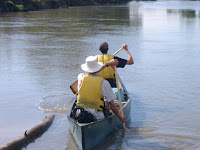 There are two more young men tackling the journey from Minnesota to Hudson Bay. It's just a coincidence, we're told, that their trip happened around the same time as the other did. Both trips - whether meant to or not - are fitting in this, the Sequicentennial of Minnesota.
There are two more young men tackling the journey from Minnesota to Hudson Bay. It's just a coincidence, we're told, that their trip happened around the same time as the other did. Both trips - whether meant to or not - are fitting in this, the Sequicentennial of Minnesota.Their names are Matthew and David Seiffert. They started out from St. Peter, MN on June 2nd. They should be reaching Pembina tomorrow.
I contacted one of the reporters that have covered the story so far, and was put in touch with their parents who have an email list they put out updates on daily. Yesterday, they had this to share; it sounds to say the least, challenging:
When we talked with Matthew early in the day (he called this morning since he couldn't reach us last night) he said that they were wet, tired, "mad at the world," and doing great. Not only did they have to endure a day of rain and showers, but they had a stiff wind in their faces (at least on average, given the way that river twists) all day. Both guys commented that they had to pay attention to which way to set out when they stopped along the shore; it wasn't always obvious which way the current was going. However, they prevailed and tonight are safely in a friend's house in Drayton, ND (the friend will be back tomorrow; don't worry - they didn't have to break in, but the story isn't worth telling here). Their next stop should be in Pembina, after which they will be in Canada.They have been continuing their round-the-clock strategy for now. To keep both of them from getting their feet excessively muddy when they stopped for a meal, only Matthew got out to do the cooking, which ultimately meant that David spent about 33 straight hours in the canoe. That raised a biological question in my mnd, but we decided that some details we don't have to know. They were glad to hear that the forecast looks better for the next few days, and other than being physically tired, sound like they are still in good spirits. We pray that the wind, if not at their backs, at least won't coninue in their faces.
 Tonight's update:
Tonight's update:These are from David's friend Kevin in Gand Forks. He noted that he had about ten minutes' notice of their arrival (and no prior knowledge of their expedition) but it seems that he enjoyed the visit.
As of Sunday night, the plan is for them to be on their way to Pembina, where they hope to rest a day. We'll let you know more when we hear from them.











